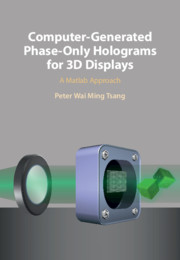Book contents
- Computer-Generated Phase-Only Holograms for 3D Displays
- Computer-Generated Phase-Only Holograms for 3D Displays
- Copyright page
- Contents
- Preface
- Acknowledgments
- 1 Introduction to Digital Holography
- 2 Fast Methods for Computer-Generated Holography
- 3 Generation of Phase-Only Fresnel Hologram
- 4 Conversion of Complex-Valued Holograms to Phase-Only Holograms
- 5 Applications of Phase-Only Hologram in Display, Holographic Encryption, and Steganography
- Index
- References
3 - Generation of Phase-Only Fresnel Hologram
Published online by Cambridge University Press: 07 January 2021
- Computer-Generated Phase-Only Holograms for 3D Displays
- Computer-Generated Phase-Only Holograms for 3D Displays
- Copyright page
- Contents
- Preface
- Acknowledgments
- 1 Introduction to Digital Holography
- 2 Fast Methods for Computer-Generated Holography
- 3 Generation of Phase-Only Fresnel Hologram
- 4 Conversion of Complex-Valued Holograms to Phase-Only Holograms
- 5 Applications of Phase-Only Hologram in Display, Holographic Encryption, and Steganography
- Index
- References
Summary
Phase-only Fresnel holograms have two major advantages over complex-valued or amplitude-only hologram. First, they can be displayed with a single phase-only SLM, leading to simplification on the holographic display system. Second, due to the high optical efficiency of phase-only holograms, the reconstructed image is brighter than that of an amplitude-only hologram. On the downside, the fidelity of the reconstructed image is degraded as a result of discarding the magnitude component of the hologram. In this chapter, a number of methods, each with pros and cons, for generating phase-only holograms are described. These methods can be divided into two types, iterative and the non-iterative. Iterative methods include the iterative Fresnel transform algorithm (IFTA) and its variants, which find their origin in the classical Gerchberg–Saxton algorithm (GSA). Reconstructed images of a phase-only hologram obtained with IFTA are generally good in quality, but the computation time is rather lengthy. Another iterative method, based on direct binary search (DBS), can be applied in generating binary phase-only holograms. Non-iterative methods are based on modifying the source image in certain ways prior to the generation of the hologram. These include noise addition, patterned phase addition, and downsampling. The modification is similar to overlaying a diffuser onto the image, so that the magnitude of the diffracted waves on the hologram is close to homogeneous. The phase component alone, therefore, can be taken to represent the hologram.
Keywords
- Type
- Chapter
- Information
- Computer-Generated Phase-Only Holograms for 3D DisplaysA Matlab Approach, pp. 76 - 112Publisher: Cambridge University PressPrint publication year: 2021

